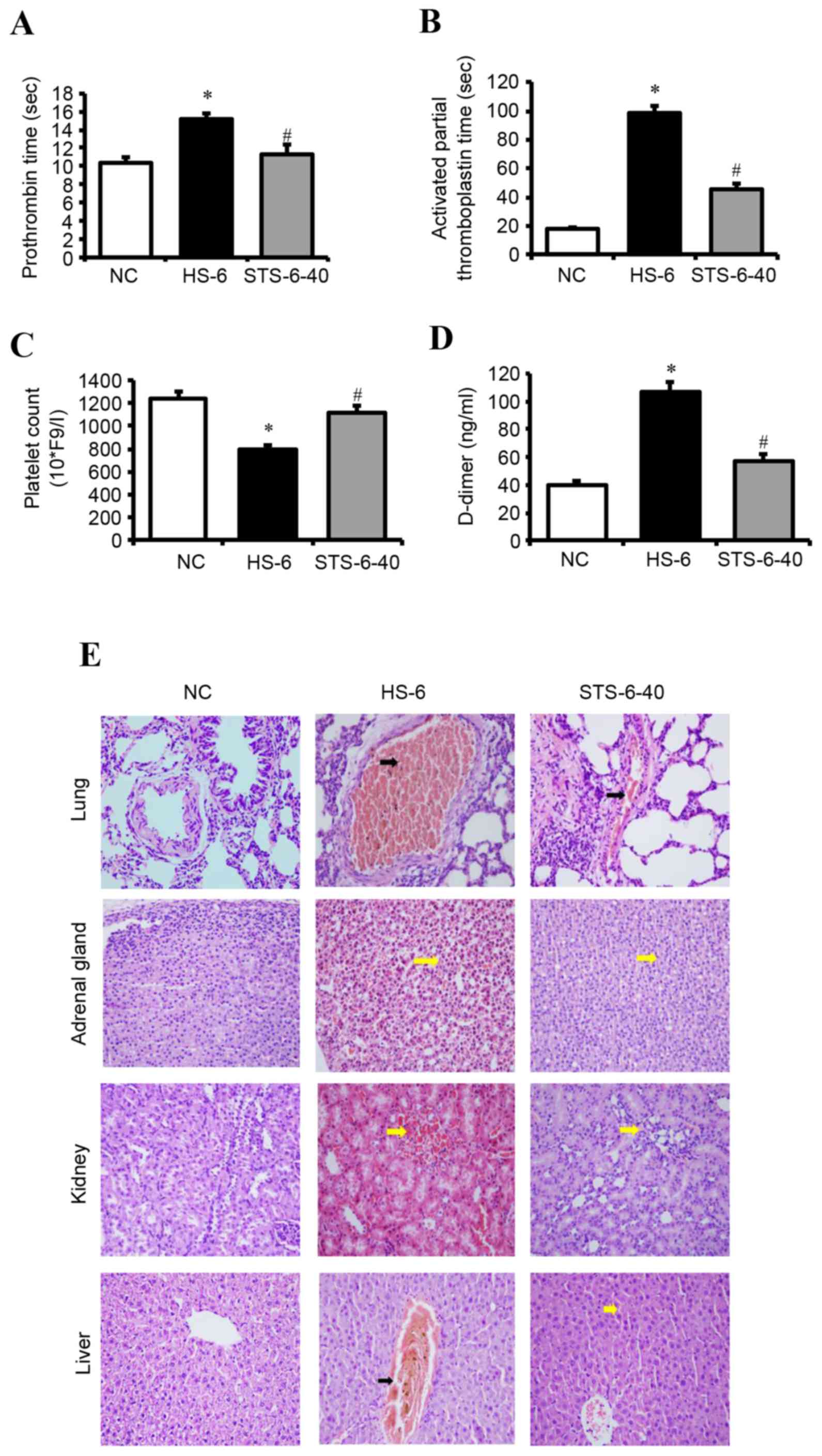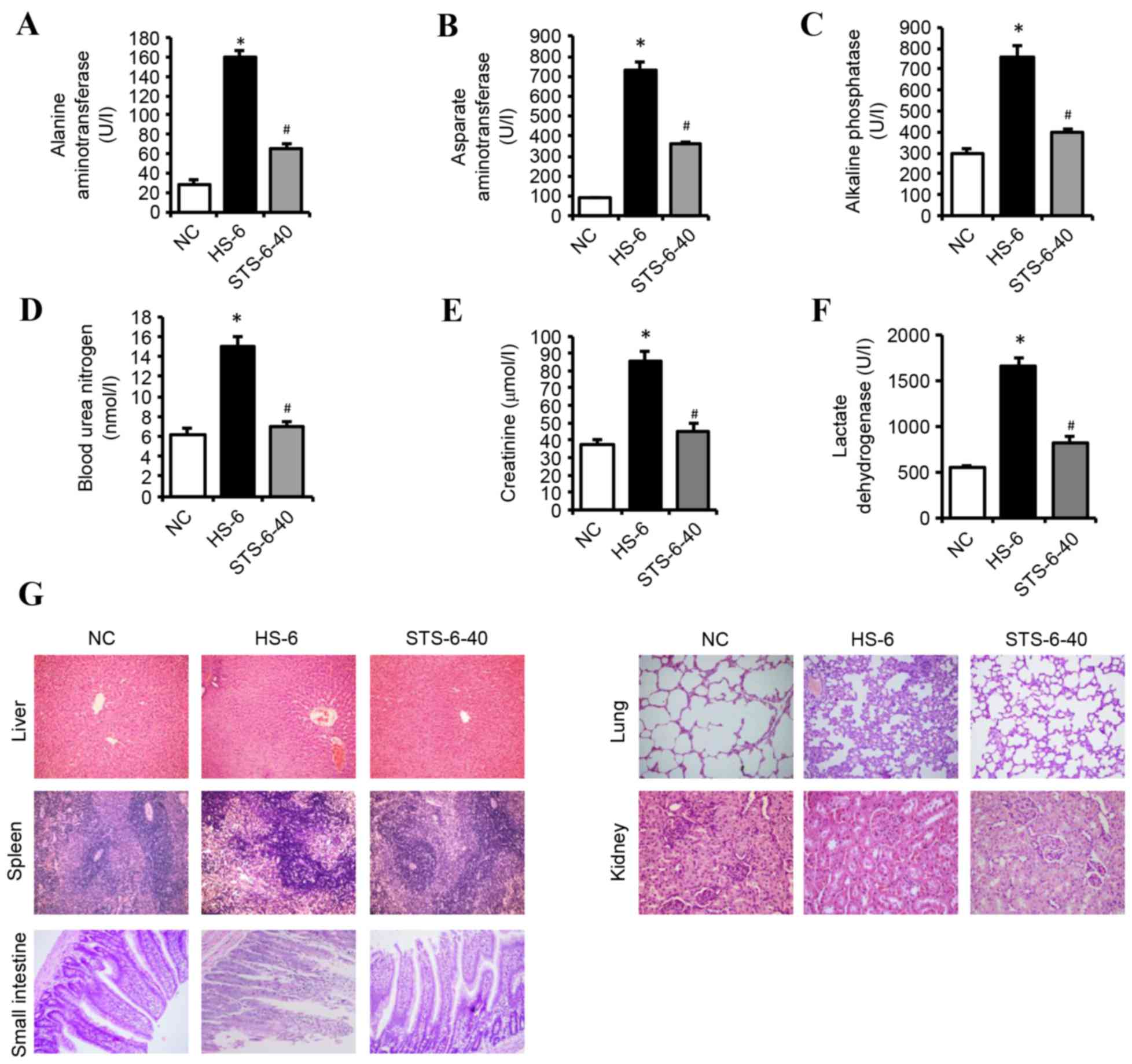|
1
|
Bouchama A and Knochel JP: Heat stroke. N
Engl J Med. 346:1978–1988. 2002. View Article : Google Scholar : PubMed/NCBI
|
|
2
|
Sucholeiki R: Heatstroke. Semin Neurol.
25:307–314. 2005. View Article : Google Scholar : PubMed/NCBI
|
|
3
|
Leon LR and Helwig BG: Heat stroke: Role
of the systemic inflammatory response. J Appl Physiol (1985).
109:1980–1988. 2010. View Article : Google Scholar : PubMed/NCBI
|
|
4
|
al-Mashhadani SA, Gader AG, al Harthi SS,
Kangav D, Shaheen FA and Bogus F: The coagulopathy of heat stroke:
Alterations in coagulation and fibrinolysis in heat stroke patients
during the pilgrimage (Haj) to Makkah. Blood Coagul Fibrinolysis.
5:731–736. 1994. View Article : Google Scholar : PubMed/NCBI
|
|
5
|
Bouchama A, Bridey F, Hcimmami MM, Lacombe
C, al-Shail E, al-Ohali Y, Combe F, al-Sedairy S and de Prost D:
Activation of coagulation and fibrinolysis in heatstroke. Thromb
Haemost. 76:909–915. 1996.PubMed/NCBI
|
|
6
|
Leon LR: Heat stroke and cytokines. Prog
Brain Res. 162:481–524. 2007. View Article : Google Scholar : PubMed/NCBI
|
|
7
|
Levine M, LoVecchio F, Ruha AM, Chu G and
Roque P: Influence of drug use on morbidity and mortality in
heatstroke. J Med Toxicol. 8:252–257. 2012. View Article : Google Scholar : PubMed/NCBI
|
|
8
|
Bouchama A: Heatstroke: A new look at an
ancient disease. Intensive Care Med. 21:623–625. 1995. View Article : Google Scholar : PubMed/NCBI
|
|
9
|
Chang CK, Chang CP, Chiu WT and Lin MT:
Prevention and repair of circulatory shock and cerebral
ischemia/injury by various agents in experimental heatstroke. Curr
Med Chem. 13:3145–3154. 2006. View Article : Google Scholar : PubMed/NCBI
|
|
10
|
Chen YW, Chen SH, Chou W, Lo YM, Hung CH
and Lin MT: Exercise pretraining protects against cerebral
ischaemia induced by heat stroke in rats. Br J Sports Med.
41:597–602. 2007. View Article : Google Scholar : PubMed/NCBI
|
|
11
|
Liu CC, Shih MF, Wen YS, Lai YH and Yang
TH: Dexamethasone improves heat stroke-induced multiorgan
dysfunction and damage in rats. Int J Mol Sci. 15:21299–21313.
2014. View Article : Google Scholar : PubMed/NCBI
|
|
12
|
Niu KC, Lin MT and Chang CP: Hyperbaric
oxygen improves survival in heatstroke rats by reducing multiorgan
dysfunction and brain oxidative stress. Eur J Pharmacol.
569:94–102. 2007. View Article : Google Scholar : PubMed/NCBI
|
|
13
|
Shang Q, Xu H and Huang L: Tanshinone IIA:
A promising natural cardioprotective agent. Evid Based Complement
Alternat Med. 2012:7164592012. View Article : Google Scholar : PubMed/NCBI
|
|
14
|
Li W, Li J, Ashok M, Wu R, Chen D, Yang L,
Yang H, Tracey KJ, Wang P, Sama AE and Wang H: A cardiovascular
drug rescues mice from lethal sepsis by selectively attenuating a
late-acting proinflammatory mediator, high mobility group box 1. J
Immunol. 178:3856–3864. 2007. View Article : Google Scholar : PubMed/NCBI
|
|
15
|
Zhou GY, Zhao BL, Hou JW, Ma GE and Xin
WJ: Protective effects of sodium tanshinone IIA sulphonate against
adriamycin-induced lipid peroxidation in mice hearts in vivo and in
vitro. Pharmacol Res. 40:487–491. 1999. View Article : Google Scholar : PubMed/NCBI
|
|
16
|
Zhang MQ, Zheng YL, Chen H, Tu JF, Shen Y,
Guo JP, Yang XH, Yuan SR, Chen LZ, Chai JJ, et al: Sodium
tanshinone IIA sulfonate protects rat myocardium against
ischemia-reperfusion injury via activation of PI3K/Akt/FOXO3A/Bim
pathway. Acta Pharmacol Sin. 34:1386–1396. 2013. View Article : Google Scholar : PubMed/NCBI
|
|
17
|
Yang R, Liu A, Ma X, Li L, Su D and Liu J:
Sodium tanshinone IIA sulfonate protects cardiomyocytes against
oxidative stress-mediated apoptosis through inhibiting JNK
activation. J Cardiovasc Pharmacol. 51:396–401. 2008. View Article : Google Scholar : PubMed/NCBI
|
|
18
|
Yang L, Zou X, Liang Q, Chen H, Feng J,
Yan L, Wang Z, Zhou D, Li S, Yao S and Zheng Z: Sodium tanshinone
IIA sulfonate depresses angiotensin II-induced cardiomyocyte
hypertrophy through MEK/ERK pathway. Exp Mol Med. 39:65–73. 2007.
View Article : Google Scholar : PubMed/NCBI
|
|
19
|
Wu TW, Zeng H, Fung KP, Wu J, Pang H, Grey
AA, Weisel RD and Wang JY: Effect of sodium tanshinone IIA
sulfonate in the rabbit myocardium and on human cardiomyocytes and
vascular endothelial cells. Biochem Pharmacol. 46:2327–2332. 1993.
View Article : Google Scholar : PubMed/NCBI
|
|
20
|
Bombeli T, Karsan A, Tait JF and Harlan
JM: Apoptotic vascular endothelial cells become procoagulant.
Blood. 89:2429–2442. 1997.PubMed/NCBI
|
|
21
|
Clark JD, Baldwin RL, Bayne KA, Manyland
R, Brown MJ, Gebhart GF, Gonder JC, Gwathmey JK, Keeling ME, Kohn
DF, et al: Guide for the Care and Use of Laboratory Animals. The
national academies press; 1996
|
|
22
|
Roberts GT, Ghebeh H, Chishti MA,
Al-Mohanna F, El-Sayed R, Al-Mohanna F and Bouchama A:
Microvascular injury, thrombosis, inflammation, and apoptosis in
the pathogenesis of heatstroke: A study in baboon model.
Arterioscler Thromb Vasc Biol. 28:1130–1136. 2008. View Article : Google Scholar : PubMed/NCBI
|
|
23
|
Bouchama A, Hammami MM, Haq A, Jackson J
and al-Sedairy S: Evidence for endothelial cell activation/injury
in heatstroke. Crit Care Med. 24:1173–1178. 1996. View Article : Google Scholar : PubMed/NCBI
|
|
24
|
Tong H, Wan P, Zhang X, Duan P, Tang Y,
Chen Y, Tang L and Su L: Vascular endothelial cell injury partly
induced by mesenteric lymph in heat stroke. Inflammation. 37:27–34.
2014. View Article : Google Scholar : PubMed/NCBI
|
|
25
|
Lovren F and Verma S: Evolving role of
microparticles in the pathophysiology of endothelial dysfunction.
Clin Chem. 59:1166–1174. 2013. View Article : Google Scholar : PubMed/NCBI
|
|
26
|
Yamakawa K, Matsumoto N, Imamura Y, Muroya
T, Yamada T, Nakagawa J, Shimazaki J, Ogura H, Kuwagata Y and
Shimazu T: Electrical vagus nerve stimulation attenuates systemic
inflammation and improves survival in a rat heatstroke model. PLoS
One. 8:e567282013. View Article : Google Scholar : PubMed/NCBI
|
|
27
|
Leon LR, Blaha MD and DuBose DA: Time
course of cytokine, corticosterone, and tissue injury responses in
mice during heat strain recovery. J Appl Physiol (1985).
100:1400–1409. 2006. View Article : Google Scholar : PubMed/NCBI
|
|
28
|
Brinton MR, Tagge CA, Stewart RJ, Cheung
AK, Shiu YT and Christensen DA: Thermal sensitivity of endothelial
cells on synthetic vascular graft material. Int J Hyperthermia.
28:163–174. 2012. View Article : Google Scholar : PubMed/NCBI
|
|
29
|
Gu ZT, Wang H, Li L, Liu YS, Deng XB, Huo
SF, Yuan FF, Liu ZF, Tong HS and Su L: Heat stress induces
apoptosis through transcription-independent p53-mediated
mitochondrial pathways in human umbilical vein endothelial cell.
Sci Rep. 4:44692014. View Article : Google Scholar : PubMed/NCBI
|
|
30
|
Zhou ZW, Xie XL, Zhou SF and Li CG:
Mechanism of reversal of high glucose-induced endothelial nitric
oxide synthase uncoupling by tanshinone IIA in human endothelial
cell line EA.hy926. Eur J Pharmacol. 697:97–105. 2012. View Article : Google Scholar : PubMed/NCBI
|
|
31
|
Jang SI, Jeong SI, Kim KJ, Kim HJ, Yu HH,
Park R, Kim HM and You YO: Tanshinone IIA from salvia miltiorrhiza
inhibits inducible nitric oxide synthase expression and production
of TNF-alpha, IL-1beta and IL-6 in activated RAW 264.7 cells.
Planta Med. 69:1057–1059. 2003. View Article : Google Scholar : PubMed/NCBI
|
|
32
|
Jang SI, Kim HJ, Kim YJ, Jeong SI and You
YO: Tanshinone IIA inhibits LPS-induced NF-kappaB activation in RAW
264.7 cells: Possible involvement of the NIK-IKK, ERK1/2, p38 and
JNK pathways. Eur J Pharmacol. 542:1–7. 2006. View Article : Google Scholar : PubMed/NCBI
|
|
33
|
Vallet B and Wiel E: Endothelial cell
dysfunction and coagulation. Crit Care Med. 29:(Suppl 7). S36–S41.
2001. View Article : Google Scholar : PubMed/NCBI
|
|
34
|
Bouvy C, Gheldof D, Chatelain C, Mullier F
and Dogné JM: Contributing role of extracellular vesicles on
vascular endothelium haemostatic balance in cancer. J Extracell
Vesicles. 3:Jul 11–2014.doi: 10.3402/jev.v3.24400. View Article : Google Scholar : PubMed/NCBI
|
|
35
|
Schouten M, Wiersinga WJ, Levi M and van
der Poll T: Inflammation, endothelium, and coagulation in sepsis. J
Leukoc Biol. 83:536–545. 2008. View Article : Google Scholar : PubMed/NCBI
|
|
36
|
Chen CM, Hou CC, Cheng KC, Tian RL, Chang
CP and Lin MT: Activated protein C therapy in a rat heat stroke
model. Crit Care Med. 34:1960–1966. 2006. View Article : Google Scholar : PubMed/NCBI
|
|
37
|
Ockelford PA and Carter CJ: Disseminated
intravascular coagulation: The application and utility of
diagnostic tests. Semin Thromb Hemost. 8:198–216. 1982. View Article : Google Scholar : PubMed/NCBI
|
|
38
|
Sohal RS, Sun SC, Colcolough HL and Burch
GE: Heat stroke. An electron microscopic study of endothelial cell
damage and disseminated intravascular coagulation. Arch Intern Med.
122:43–47. 1968. View Article : Google Scholar : PubMed/NCBI
|
|
39
|
Lin XJ, Mei GP, Liu J, Li YL, Zuo D, Liu
SJ, Zhao TB and Lin MT: Therapeutic effects of melatonin on
heatstroke-induced multiple organ dysfunction syndrome in rats. J
Pineal Res. 50:436–444. 2011. View Article : Google Scholar : PubMed/NCBI
|













